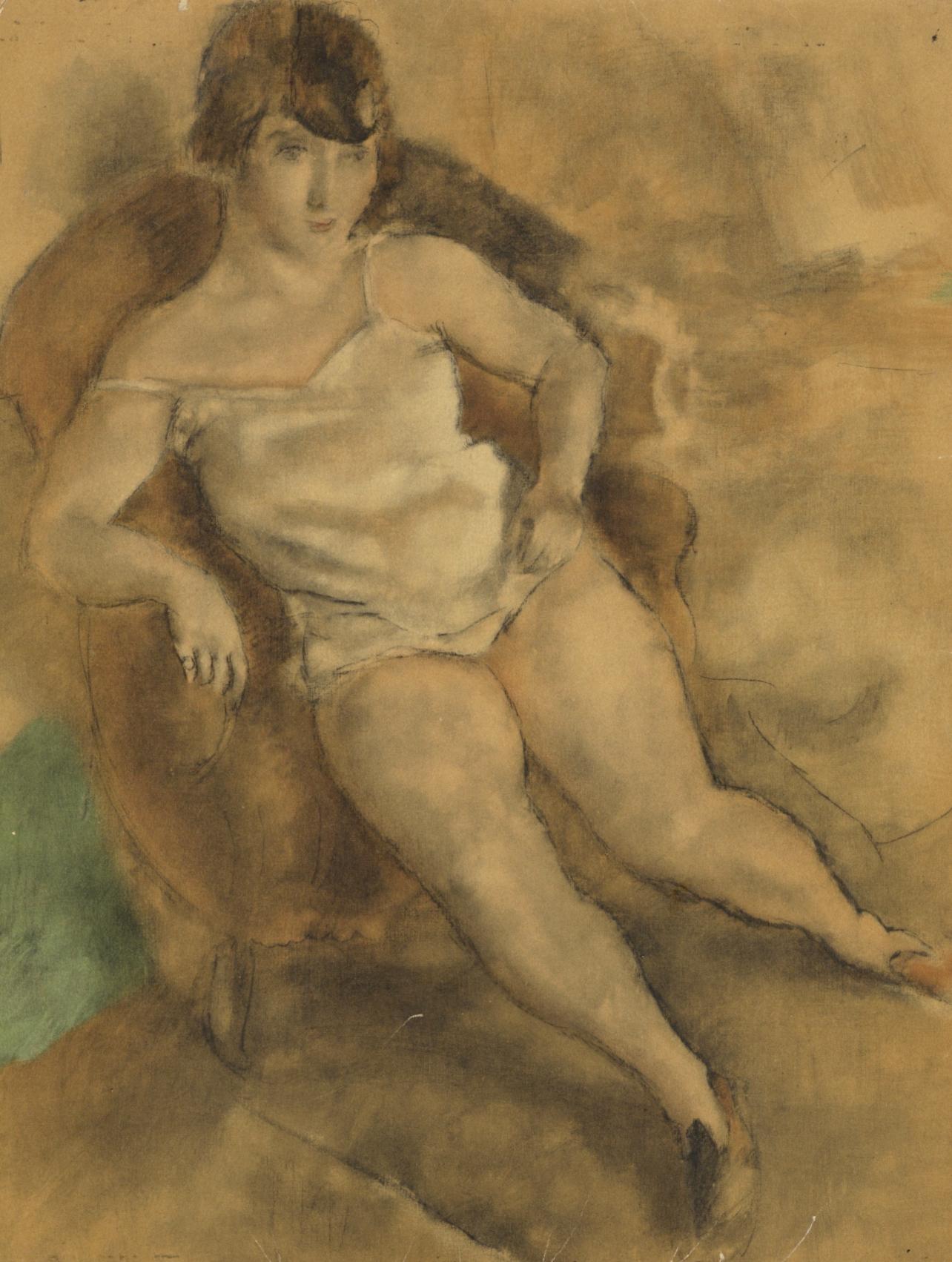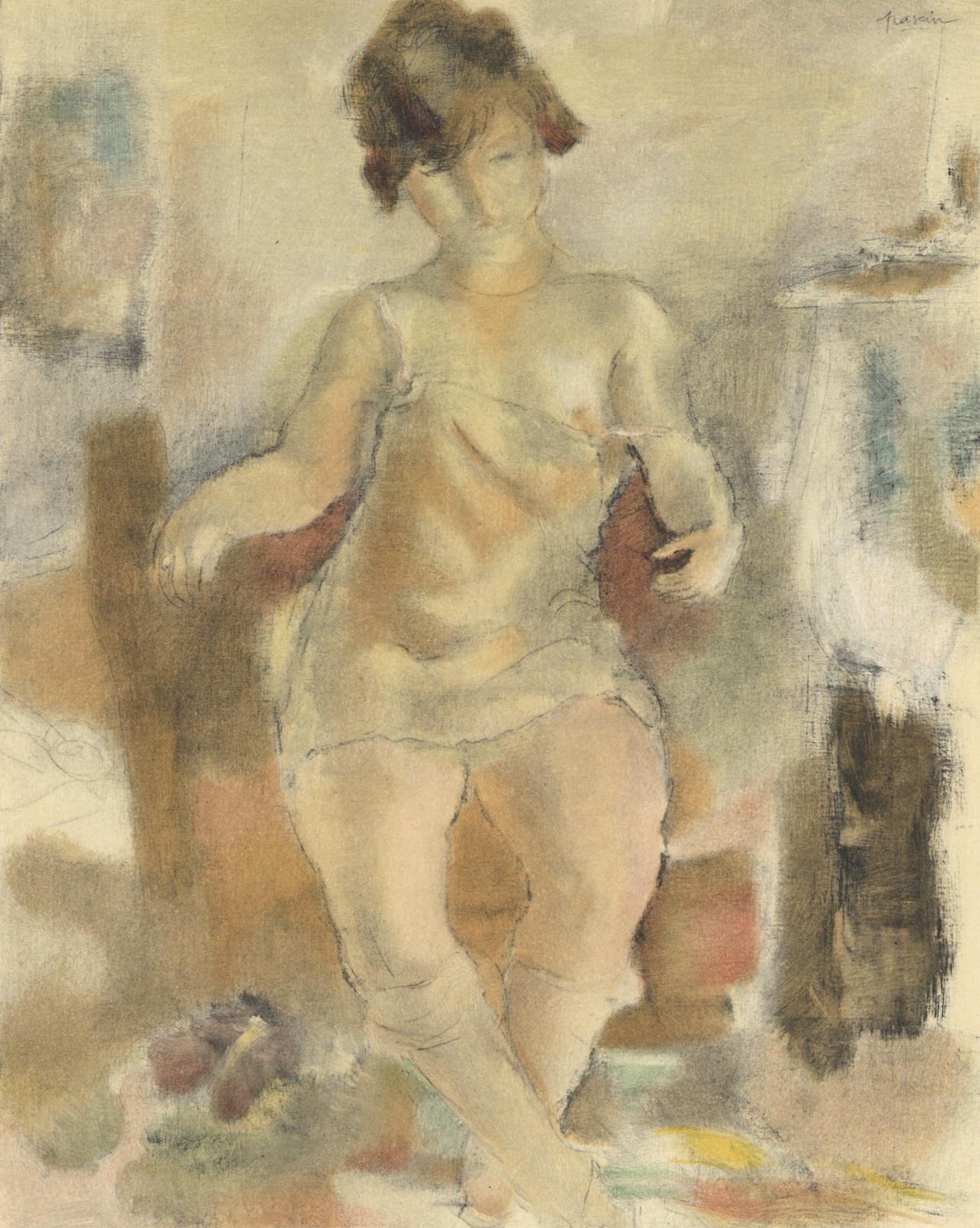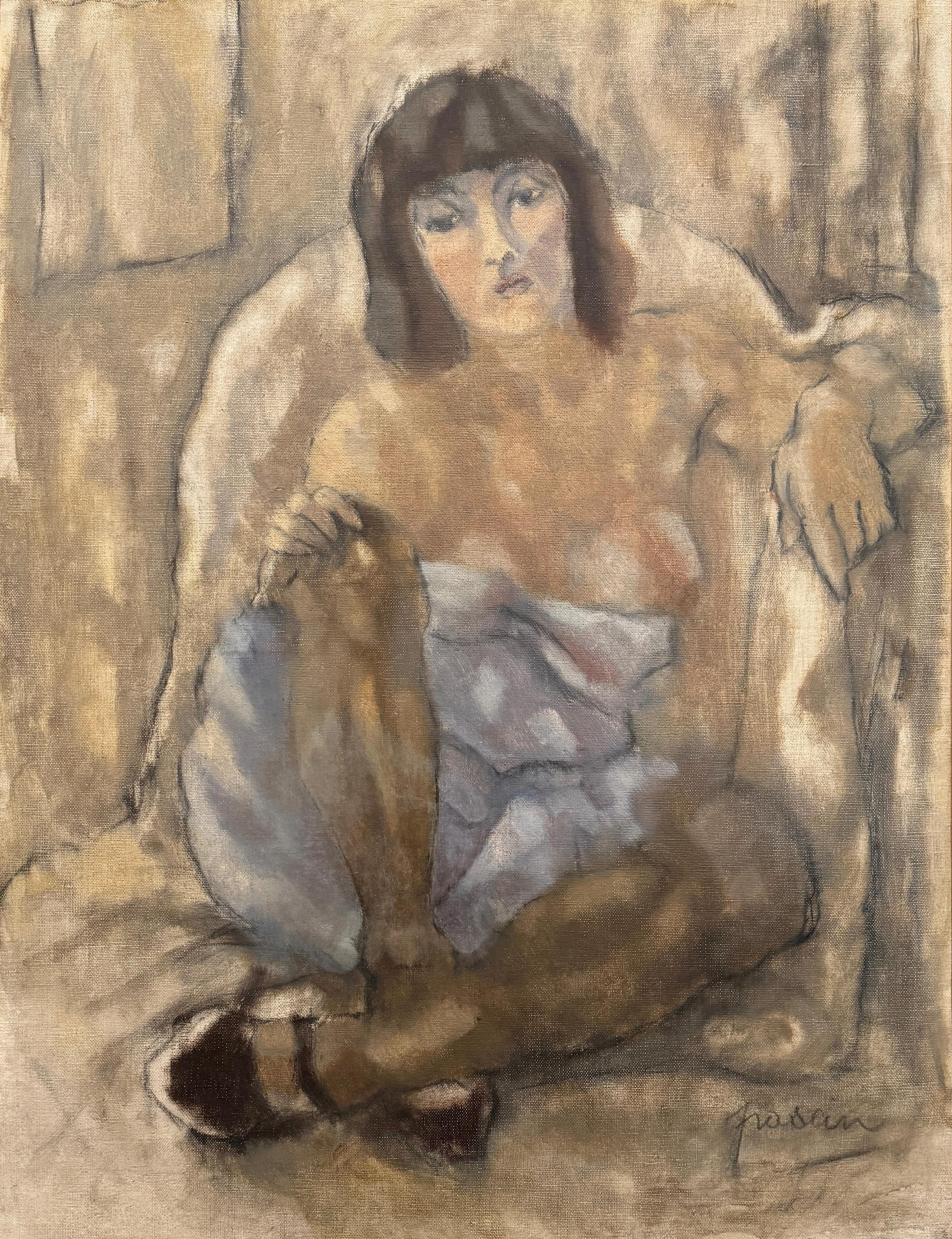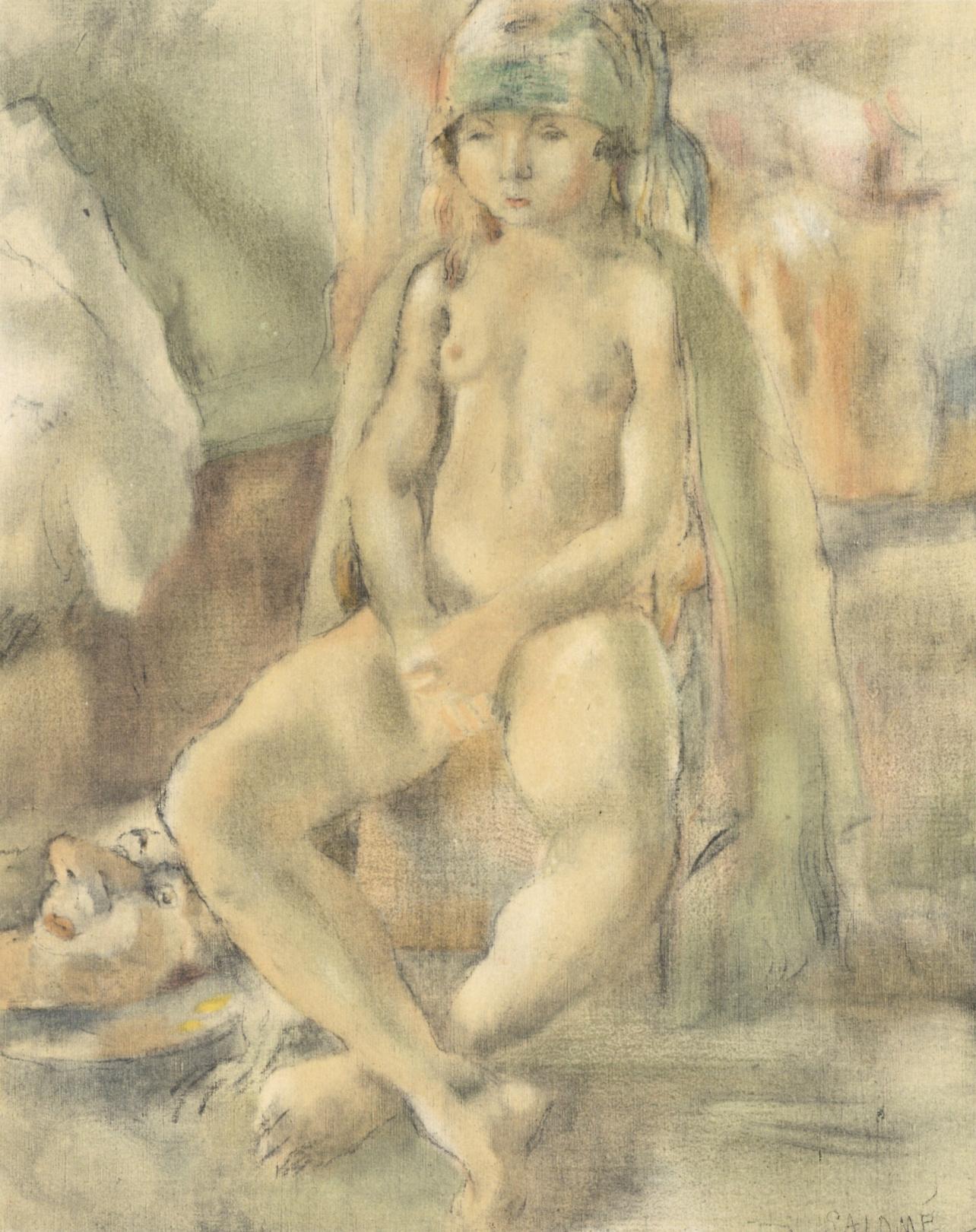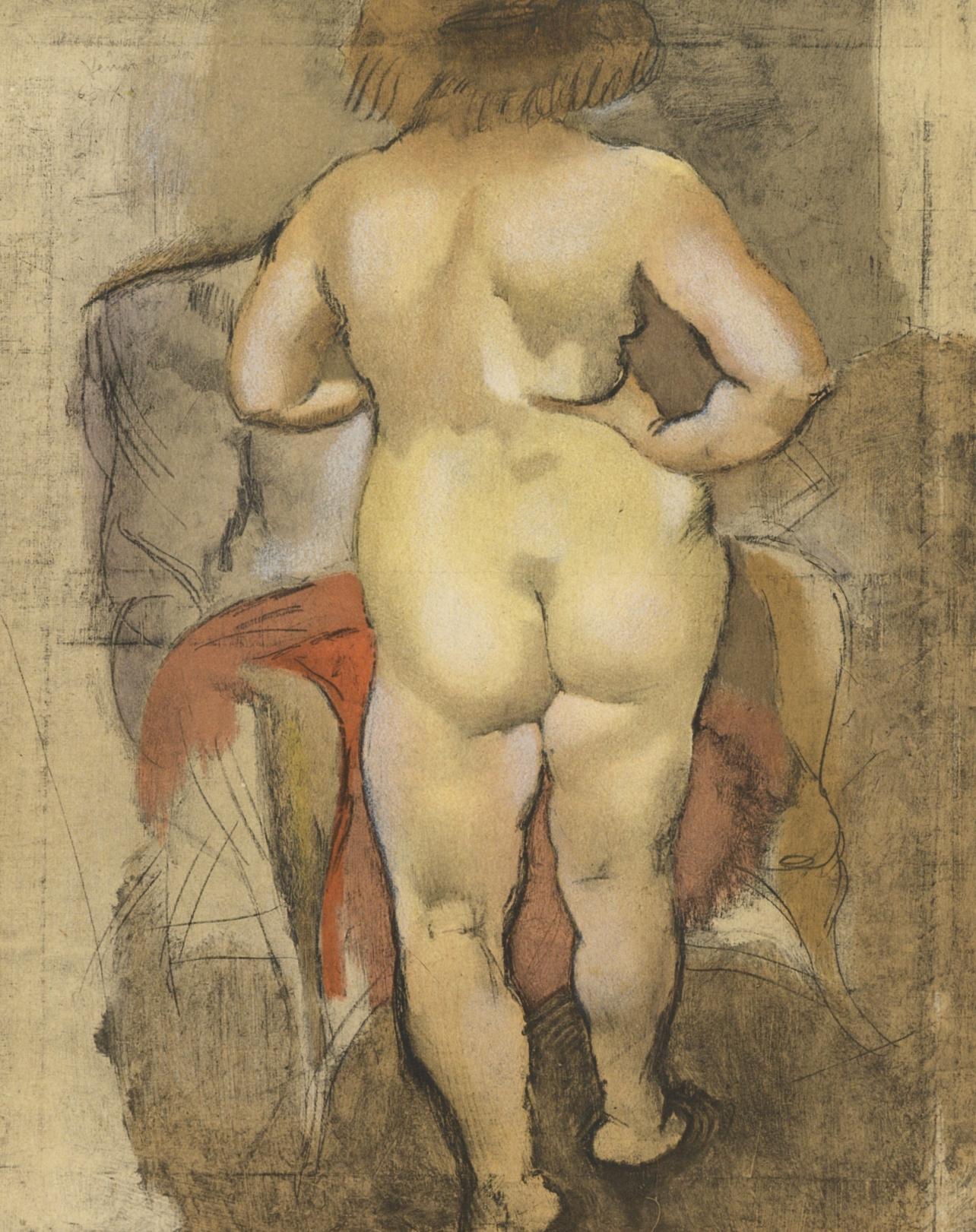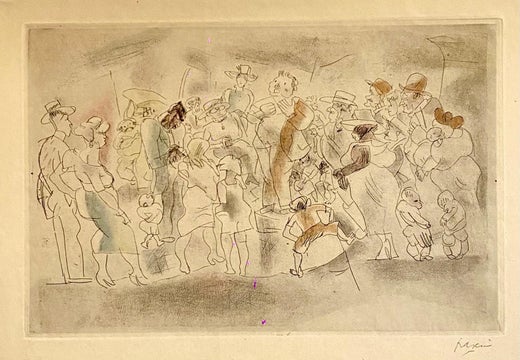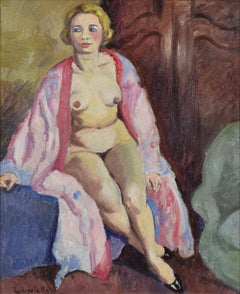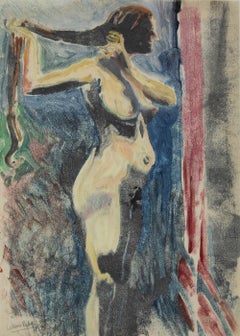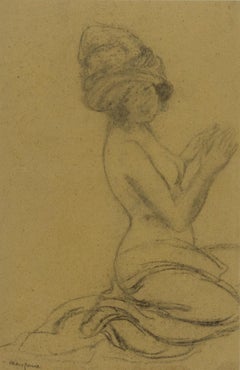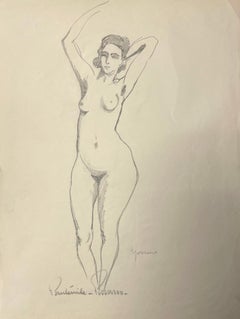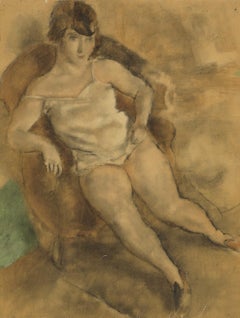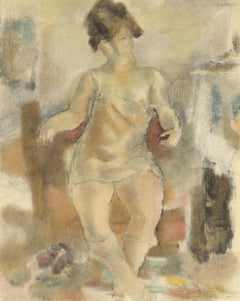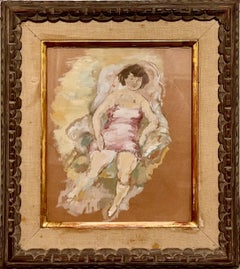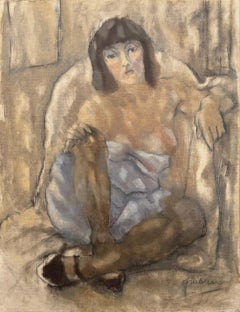Items Similar to Rebecca Couchée by JULES PASCIN - School of Paris, Nude Painting, Figurative Art
Want more images or videos?
Request additional images or videos from the seller
1 of 6
Jules PascinRebecca Couchée by JULES PASCIN - School of Paris, Nude Painting, Figurative Art1927
1927
$90,000
£66,944.78
€78,379.12
CA$125,580.56
A$140,528.17
CHF 73,377.21
MX$1,727,647.63
NOK 925,738.10
SEK 871,114.99
DKK 584,768.30
Shipping
Retrieving quote...The 1stDibs Promise:
Authenticity Guarantee,
Money-Back Guarantee,
24-Hour Cancellation
About the Item
*UK BUYERS WILL PAY AN ADDITIONAL 5% IMPORT DUTY ON TOP OF THE ABOVE PRICE
Rebecca Couchée by JULES PASCIN (1885-1930)
Oil over pencil on canvas
73.1 x 91.8 cm (28 ¾ x 36 ⅛ inches)
Signed lower right, Pascin
Executed in 1927, Boulevard de Clichy, Paris
Provenance
Collection Marcel Bernheim, Palais des Beaux-Arts de Bruxelles, acquired from the artist, 1928
Pierre Blum, Paris, acquired from the above, 1952
Perls Galleries, New York, no. 13565
Private collection, Osaka
Sotheby’s, New York, 14th May 1998
Peter Findlay Gallery Inc., New York
Private collection, USA, acquired from the above, June 2011
Literature
Luis Seoane, Pascin, Editorial Poseidon, Buenos Aires, 1944, 1st ed., no. 25, p. 64 (illustrated and titled Mujer Desnuda Tendida)
Y. Hemin, G. Krogh, K. Perls and A. Rambert, Pascin: Catalogue Raisonné, Peintures, Aquarelles, Pastels, Dessins, Paris, 1984, vol. 1, p. 303, no. 597 (illustrated)
This is a top example but this most important School of Paris painter
Artist biography
Bulgarian-Jewish artist Jules Pascin was born Julius Mordecai Pincas at Vidin in Bulgaria to a wealthy Spanish father and Serbian-Italian mother, and brought up in Bucharest where some of his earliest drawings were surreptitiously undertaken in a local brothel. Indeed, throughout his career, his most frequent subject was the female body, often in casual poses, nude or partly dressed. Educated initially in Vienna and later at artist Moritz Heymann’s academy in Munich, the artist spent a brief period in Berlin employed in the creation of satirical magazine drawings. It was his father’s embarrassment over precisely these drawings that forced the artist, at the age of twenty, to change his name to ‘Jules Pascin’ (Pascin being an anagram of Pincas).
In December 1905, Pascin moved to Paris and began contributing drawings to Simplicissimus, a satirical German magazine published in Munich. His first paintings were influenced by Cézanne and the Fauves and were exhibited in his first solo exhibition at the Paul Cassirer Gallery in Berlin. Pascin continued to exhibited his works at the Salon d’Automne and the Salon des Indépendants in Paris, the Berlin Secession and the Sonderbund-Aussstellung in Cologne. He also regularly exhibited drawings, caricatures and prints, many of which were sold to various newspapers and magazines. Depressed over his inability to achieve critical success as a painter, Pascin enrolled at the Académie Colarossi in Paris to deepen his training and devoted much of his attention to copying Old Masters in the Louvre. Twelve of his works were shown at the famous 1913 Armory Show in New York City.
To avoid service in the Bulgarian army during the First World War, Pascin escaped to London and left for the United States in October 1914. A few weeks later his lover and future-wife, the painter Hermine David (whom he met in 1907) sailed to join him and both remained in the United States for the duration of the war. They settled in the Southern states where Pascin took American citizenship and taught art in Savannah (Georgia) before marrying David at New York City in 1918 (witnessed by the painters Max Weber and Maurice Sterne).
Returning to Paris in 1922. Pascin and his wife rented a studio in Montmartre and became friends with artists such as Marc Chagall and Amedeo Modigliani. His models were the local dancer girls and prostitutes and Pascin soon became an icon of the bohemian community inheriting the sobriquet 'The Prince of Montparnasse'. Throughout the 1920s the artist produced a series of fleetingly rendered oil paintings, depicting petite filles waiting for their clients and models anticipating the end of their sitting. These pictures sold readily, but the money was quickly spent which forced Pascin to supplement his income as a book illustrator. A witty presence, always wearing a bowler hat, Pascin was famous as the host of numerous large parties and whenever he was invited elsewhere for dinner he arrived with as many bottles of wine as he could carry. One of his Parisian of the period was Ernest Hemingway, whose memoir A Moveable Feast includes a chapter called "With Pascin At the Dôme" which recounts a night in 1923 with Pascin and two of his young models.
On the eve of his ever solo exhibition in 1930 at the Galerie Georges Petit in Paris a tormented Pascin, who had struggled for many years with depression and alcoholism, committed suicide. "[D]riven to the wall by his own legend" according to art critic Gaston Diehl, Pascin died aged forty-five after slitting his wrists and hanging himself in the studio at 36 Boulevard de Clichy in Montmartre. Hauntingly, he left a message written on the wall in blood for his mistress Lucy Krohg. As a mark of exceptional respect, several of the galleries in Paris closed on the day of his funeral when thousands from the artistic community – including waiters and bartenders from the restaurants and saloons Pascin had frequented - all dressed in black, walked for three miles behind his coffin.
- Creator:Jules Pascin (1885-1930, Bulgarian, French)
- Creation Year:1927
- Dimensions:Height: 28.78 in (73.1 cm)Width: 36.15 in (91.8 cm)
- Medium:
- Movement & Style:
- Period:
- Condition:
- Gallery Location:London, GB
- Reference Number:1stDibs: LU261210205702
Jules Pascin
Jules Pascin was born Julius Mordecai Pincas, in Widdin, Bulgaria to a Spanish-Sephardic Jewish father and a Serbian-Italian mother. His early artistic training was in Vienna and Munich. In 1905, at the age of 20, he adopted the pseudonym Pascin (an anagram of Pincas). About the same time, he began contributing drawings to Simplicissimus, a satirical magazine published in Munich. In December 1905, Pascin moved to Paris, becoming part of the great migration of artists to that city at the start of the 20th century. In 1907, Pascin met Hermine Lionette Cartan David, also a painter, and they became lovers. They lived together until Pascin left for America on October 3, 1914. A few weeks later on October 31, Hermine David sailed for the United States to join Pascin. Pascin lived in the United States from 1914 to 1920, sitting out World War I. He taught at the Telfair Academy in Savannah, Georgia, associated with the Telfair Art Museum. He and Hermine painted in New York City as well as in Miami, New Orleans, and Cuba. Despite his social life, Pascin created thousands of watercolors and sketches, plus drawings and caricatures, which he sold to various newspapers and magazines. He studied the art of drawing at the Académie Colarossi and, like Henri de Toulouse-Lautrec, he drew upon his surroundings and his friends, both male and female, as subjects. He wanted to become a serious painter, but in time, he became deeply depressed over his inability to achieve critical success with his efforts. During the 1920s, Pascin mostly painted fragile petites filles, prostitutes waiting for clients, or models waiting for the sitting to end. His fleetingly rendered paintings sold readily, but the money he made was quickly spent. Famous as the host of numerous large parties in his flat, whenever he was invited elsewhere for dinner, he arrived with as many bottles of wine as he could carry. He frequently led a large group of friends on summer picnics beside the River Marne, where their excursions lasted all afternoon. Ernest Hemingway's chapter titled "With Pascin At the Dôme," in A Moveable Feast, recounted a night in 1923 when he had stopped off at Le Dôme and met Pascin escorted by two models. Hemingway's portrayal of the evening is considered one of the defining images of Montparnasse at the time. Pascin struggled with depression and alcoholism. "[D]riven to the wall by his own legend," according to art critic Gaston Diehl, he committed suicide at the age of 45 on the eve of a prestigious solo show. He slit his wrists and hung himself in his studio in Montmartre. On the wall he left a message written in blood, to a former lover, Cecile (Lucy) Vidil Krohg In his last will and testament, Pascin left his estate equally to his wife, Hermine David, and his mistress Lucy Krohg.
About the Seller
5.0
Recognized Seller
These prestigious sellers are industry leaders and represent the highest echelon for item quality and design.
Established in 1964
1stDibs seller since 2015
102 sales on 1stDibs
Typical response time: 5 hours
Associations
Society Of London Art Dealers
- ShippingRetrieving quote...Shipping from: London, United Kingdom
- Return Policy
Authenticity Guarantee
In the unlikely event there’s an issue with an item’s authenticity, contact us within 1 year for a full refund. DetailsMoney-Back Guarantee
If your item is not as described, is damaged in transit, or does not arrive, contact us within 7 days for a full refund. Details24-Hour Cancellation
You have a 24-hour grace period in which to reconsider your purchase, with no questions asked.Vetted Professional Sellers
Our world-class sellers must adhere to strict standards for service and quality, maintaining the integrity of our listings.Price-Match Guarantee
If you find that a seller listed the same item for a lower price elsewhere, we’ll match it.Trusted Global Delivery
Our best-in-class carrier network provides specialized shipping options worldwide, including custom delivery.More From This Seller
View AllNu Assise by Ludovic-Rodo Pissarro - Nude painting
By Ludovic-Rodo Pissarro
Located in London, GB
Nu Assise by Ludovic-Rodo Pissarro (1878-1952)
Oil on canvas
55 x 47 cm (21 ⅝ x 18 ½ inches)
Signed lower left, Ludovic Rodo
Executed circa 1910
This work is accompanied by a cer...
Category
1910s Fauvist Nude Paintings
Materials
Canvas, Oil
Nude by Ludovic-Rodo Pissarro - Monotype
By Ludovic-Rodo Pissarro
Located in London, GB
Nude by Ludovic-Rodo Pissarro (1878-1952)
Monotype
63.5 x 46 cm (25 x 18 ⅛ inches)
Signed lower left, Ludovic Rodo
Female nudes are often considered amo...
Category
20th Century Figurative Prints
Materials
Monotype
Une Femme Turque by Georges Manzana Pissarro - Work on paper
By Georges Henri Manzana Pissarro
Located in London, GB
Une Femme Turque by Georges Manzana Pissarro (1871-1961)
Charcoal on paper
47 x 30.5 cm (18 ¹/₂ x 12 inches)
Signed lower left, manzana
Executed circa 1910
This work is accompanied ...
Category
1910s Post-Impressionist Figurative Drawings and Watercolors
Materials
Charcoal
Yvonne debout by Paulémile Pissarro - Nude drawing of the artist's wife
By Paul Emile Pissarro
Located in London, GB
THIS WORK IS SOLD UNFRAMED
Yvonne debout by Paulémile Pissarro (1884-1972)
Pencil on paper
30.5 x 26 cm (12 x 10 ¹/₄ inches)
Signed lower centre, P...
Category
1920s Post-Impressionist Nude Drawings and Watercolors
Materials
Paper, Pencil
Nu au canapé bleu by Ludovic-Rodo Pissarro - Nude painting
By Ludovic-Rodo Pissarro
Located in London, GB
Nu au canapé bleu y Ludovic-Rodo Pissarro (1878-1952)
Oil on canvas
46 x 38 cm (18 ¹/₈ x 15 inches)
Signed lower left, Ludovic Rodo
Executed circa 1910
This work is accompanied by a certificate of authenticity from Lélia Pissarro.
Provenance: Private collection, France
Artist biography:
Ludovic-Rodolphe Pissarro, born in Paris in 1878, was Camille Pissarro’s fourth son. Encouraged by his father...
Category
1910s Post-Impressionist Figurative Paintings
Materials
Canvas, Oil
Undressing by Georges Manzana Pissarro - Nude drawing
By Georges Henri Manzana Pissarro
Located in London, GB
Undressing by Georges Manzana Pissarro (1871-1961)
Pencil on paper
13.6 x 10.6 cm (5 ³/₈ x 4 ¹/₈ inches)
Signed with Estate stamp lower right, manzana- Pissarro
This work is accompa...
Category
20th Century Post-Impressionist Figurative Drawings and Watercolors
Materials
Paper, Pencil
You May Also Like
Pascin, Femme dans un fanteuil, Pascin (after)
By Jules Pascin
Located in Fairfield, CT
Medium: Lithograph on grand vélin Renage paper
Year: 1954
Paper Size: 12.25 x 9.5 inches
Inscription: Unsigned and unnumbered, as issued
Notes: From the album, Pascin, 1954. Publishe...
Category
1950s Post-Impressionist Figurative Prints
Materials
Lithograph
$716 Sale Price
20% Off
Pascin, Nu à la chemisette rose, Pascin (after)
By Jules Pascin
Located in Fairfield, CT
Medium: Lithograph on grand vélin Renage paper
Year: 1954
Paper Size: 12.25 x 9.5 inches
Inscription: Signed in the plate and unnumbered, as issued
Notes: From the album, Pascin, 195...
Category
1950s Post-Impressionist Figurative Prints
Materials
Lithograph
$716 Sale Price
20% Off
Gouache Painting Jules Pascin Hand Signed Woman in Boudoir German Expressionism
By Jules Pascin
Located in Surfside, FL
Genre: German Expressionist
Subject: Woman
Medium: gouache paint
Surface: Paper board
This is hand signed lower right.
Framed it measures 17.25 X 15.5, sheet 12 X 10
This came from a Jewish estate. there was no additional paperwork or provenance.
Julius Mordecai Pincas (March 31, 1885 – June 5, 1930), known as Pascin Jules...
Category
Early 20th Century Expressionist Figurative Paintings
Materials
Paper, Gouache, Cardboard
Femme Assise JULES PASCIN oil on canvas Seated Woman - Framed
By Jules Pascin
Located in Rancho Santa Fe, CA
Signed lower right
Framed: H 36 x W 31 x D 2.5 in.
Provenance
Lucy Krohg
Crane Kalman Gallery, London
Mr. Selig Burrows (Purchased from above, December 1984)
Private collection, New...
Category
1920s Modern Figurative Paintings
Materials
Canvas, Oil
Pascin, Salomé, Pascin (after)
By Jules Pascin
Located in Fairfield, CT
Medium: Lithograph on grand vélin Renage paper
Year: 1954
Paper Size: 12.25 x 9.5 inches
Inscription: Unsigned and unnumbered, as issued
Notes: From the album, Pascin, 1954. Publishe...
Category
1950s Post-Impressionist Figurative Prints
Materials
Lithograph
$716 Sale Price
20% Off
Pascin, Vénus de dos, Pascin (after)
By Jules Pascin
Located in Fairfield, CT
Medium: Lithograph on grand vélin Renage paper
Year: 1954
Paper Size: 12.25 x 9.5 inches
Inscription: Unsigned and unnumbered, as issued
Notes: From the album, Pascin, 1954. Publishe...
Category
1950s Post-Impressionist Figurative Prints
Materials
Lithograph
$716 Sale Price
20% Off
More Ways To Browse
Paris Restaurants
Antique Oil Bottle
Antique Coffin
Cologne Bottle
Gaston G
Antique Italian Wine Bottles
Heymann Marks
Ilya Glazunov
Ivan Aivazovsky
Ariel Zuniga
Stanley Spencer Nude Paintings
William Crosbie
Charlotte Corday
Leon Collard
Madeleine Flaschner
Marcel Rene Herrfeldt
Gerald Leake
Shana Wilson Female Nudes Paintings
